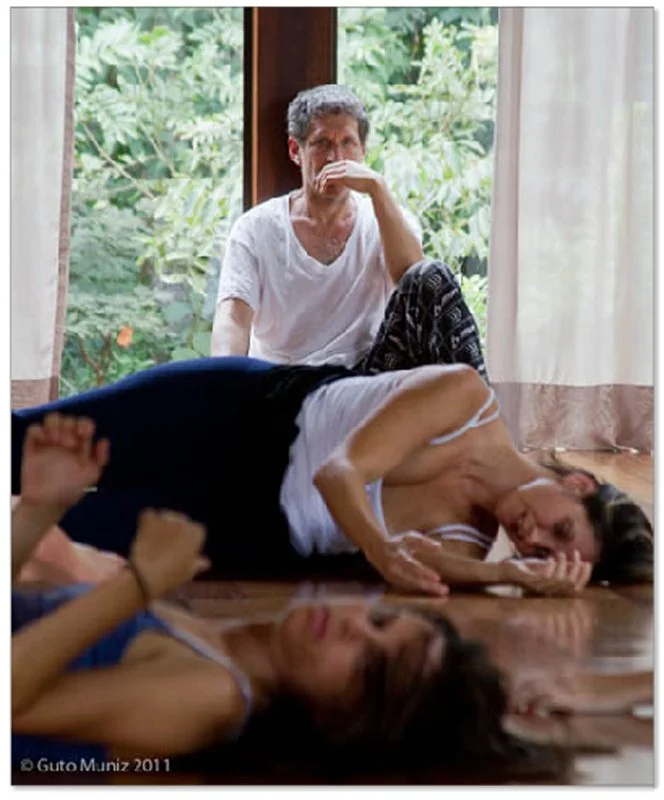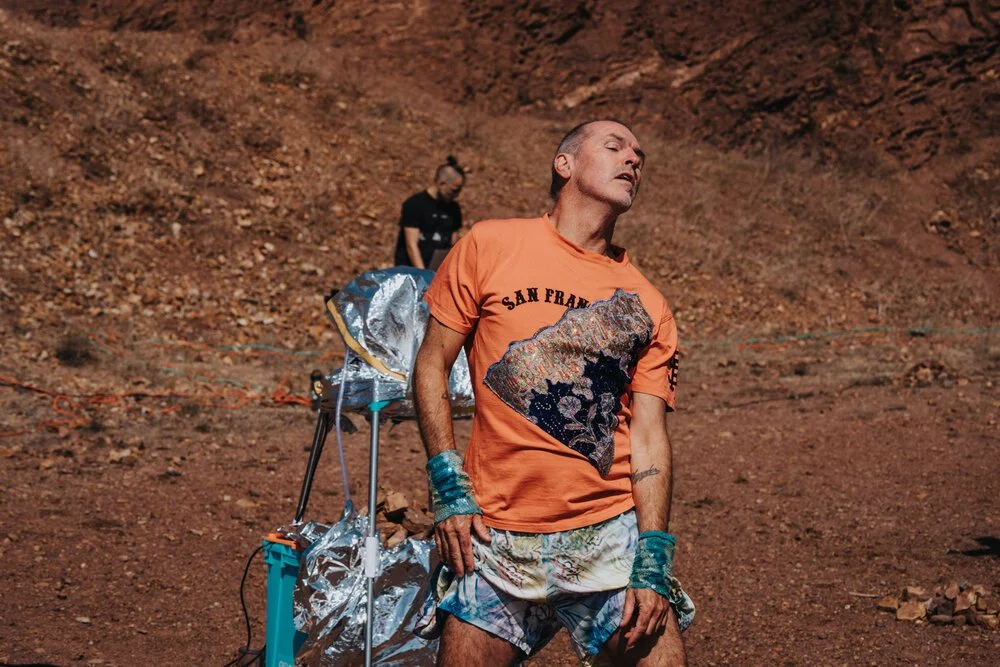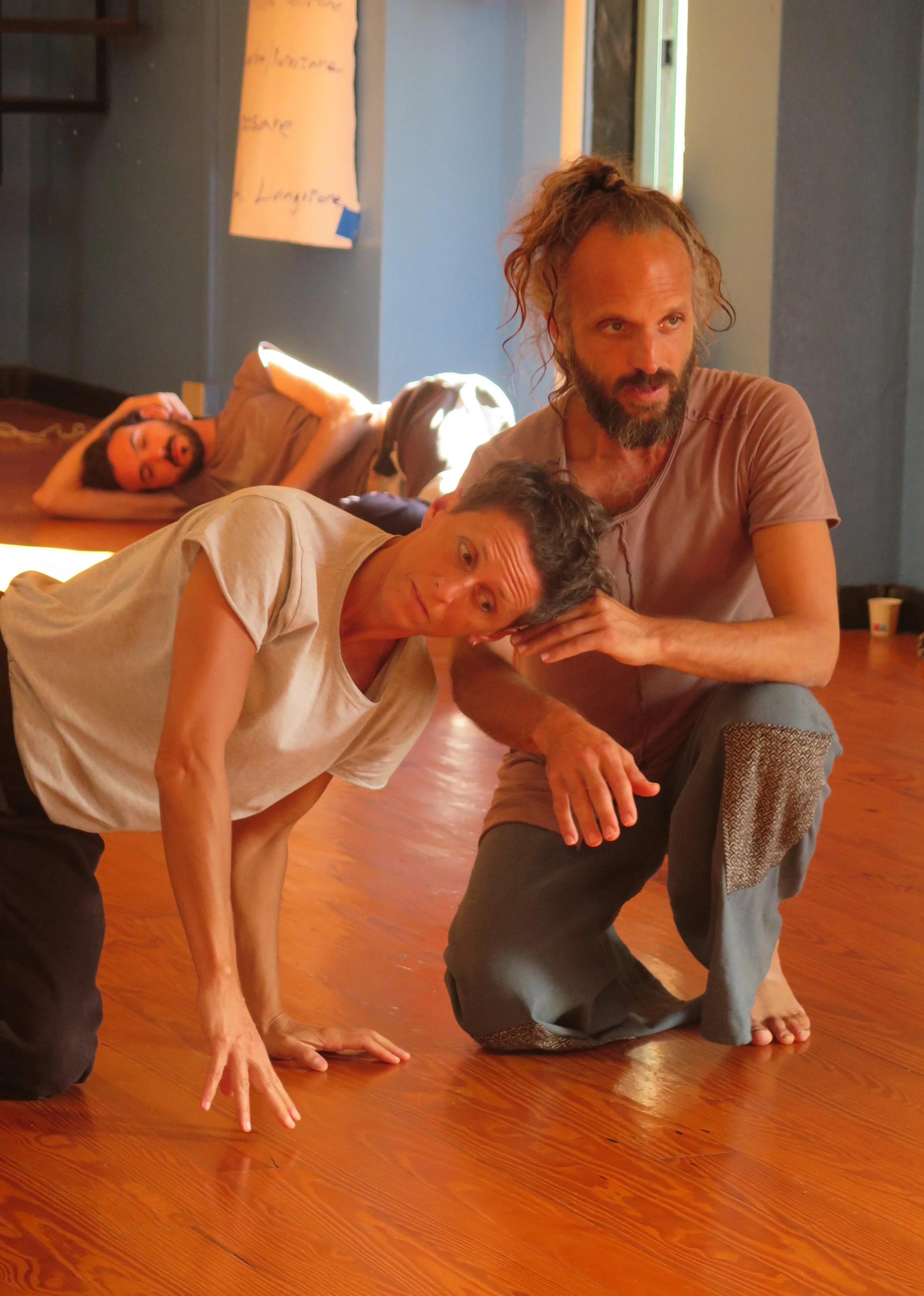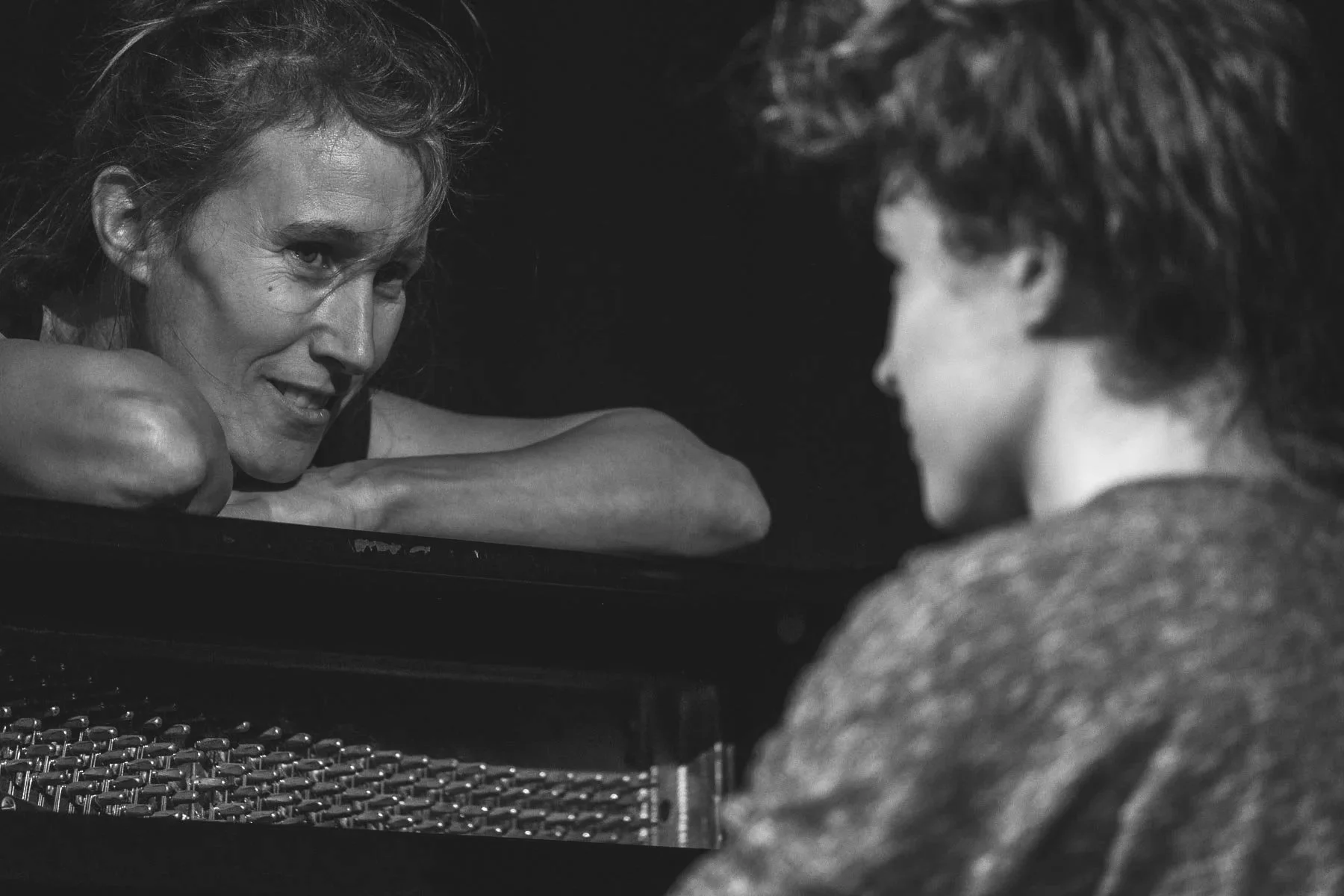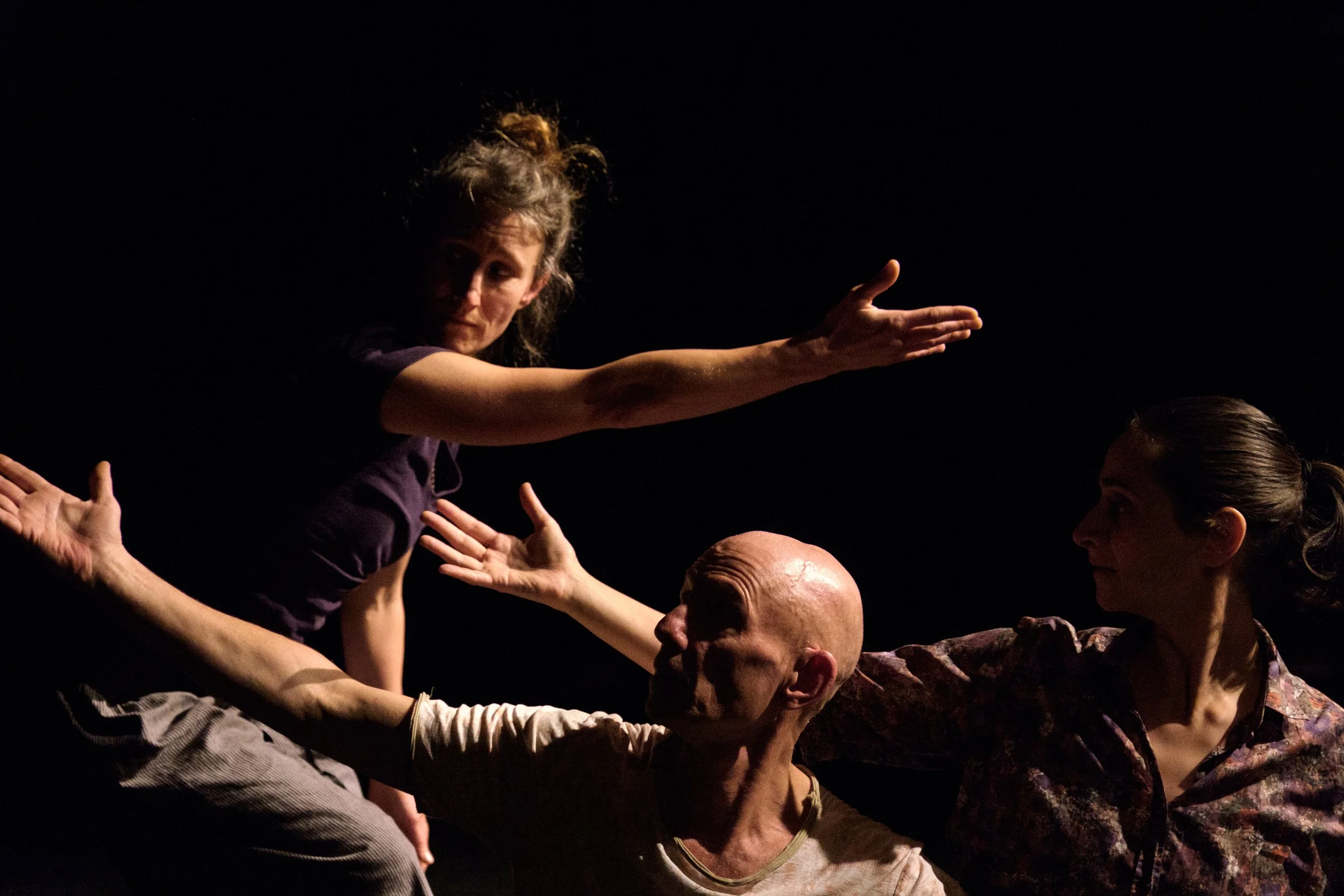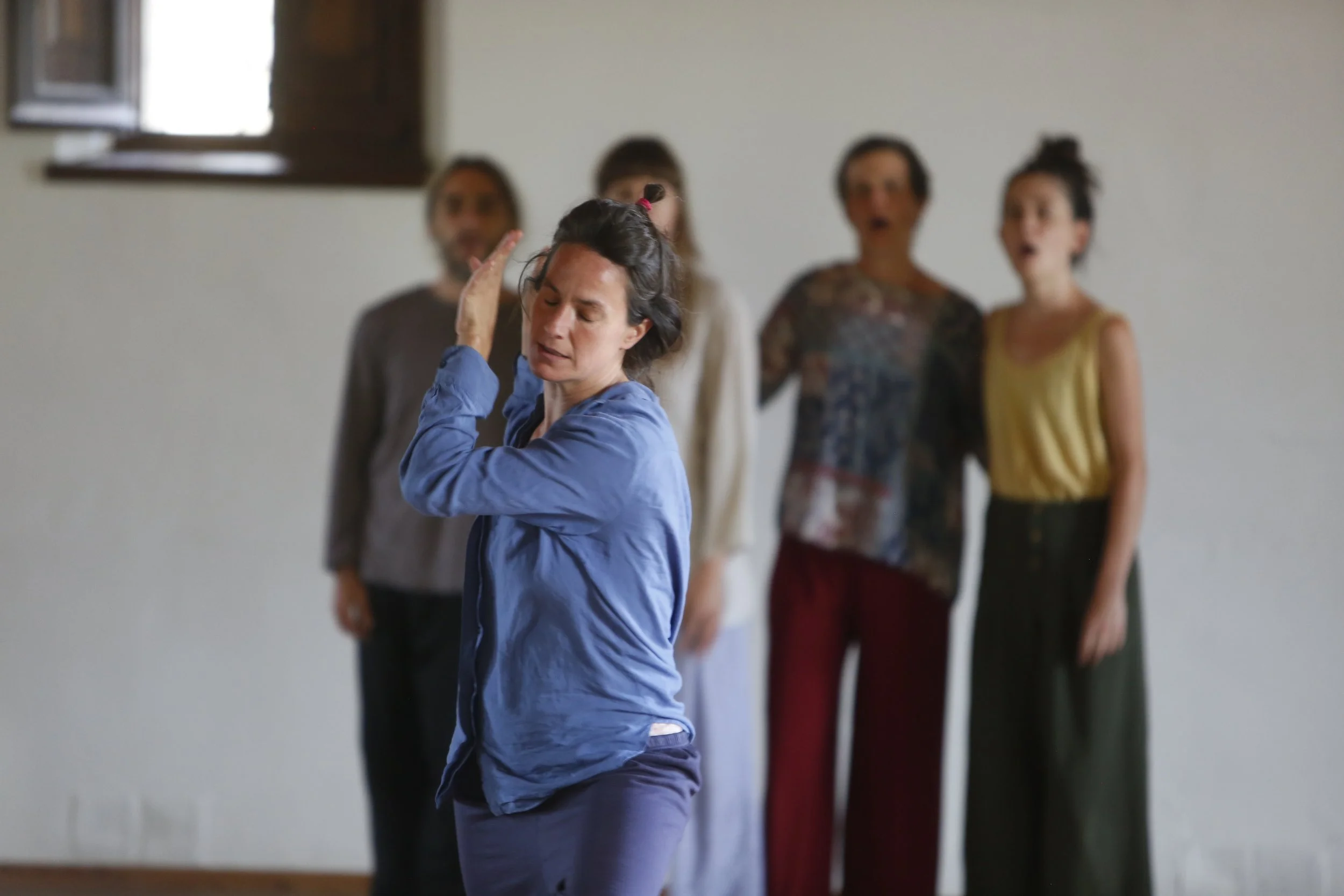TEACHERS 2026.
It is with great enthusiasm that we introduce you to this great team of international teachers.
INTENSIVES >> Daniel Lepkoff and Keith Hennessy.
CLASSES >> Asaf Bachrach, Jori Snell, Maria Mora, Paula Zacharias.
>>> INTENSIVES.
There will be two intensives happening simultaneously with a duration of 3 hours 30 minutes for five days.
DANIEL LEPKOFF (USA).
Photo: Italy Contact Festival 2019 by Aida Vargas.
DANIEL LEPKOFF is a dancer known for bringing the process of living movement into the studio and onto the stage.
Since the early '70's he played a central role in the development of Release Technique with Mary Fulkerson and Contact Improvisation with Steve Paxton. Throughout the '70's and '80's he traveled extensively; teaching, performing and exposing these new ideas worldwide.
He was one of the founders of Movement Research in NYC (1975), playing as active role in defining the initial conception of this seminal organization: designing new programs, curating events, teaching regular classes and offering intensive workshops.
Living in New York City in the '80's Daniel performed in the works of several choreographers including: Trisha Brown, Simone Forti, Mary Fulkerson, Lisa Nelson, Mary Overlie, Judy Padow, Steve Paxton, & Nancy Topf. In this period his own movement based solo and group work experimented with the elements of voice, text, film, video, & photography, and interactions with physical objects. His work has been shown at Danspace, PS122, Movement Researh at Jusdon Church, in New York City as well as internationally throughout Europe, Eastern Europe and Russia, and South America.
Over the years Daniel has engaged in several long term and important collaborations with other performing artists including: Lisa Nelson, Steve Paxton; Paul Langland, Saira Blanche Theater in Moscow (Oleg Soulimenko and Andrej Andrianov), Hungarian experimental musician Dora Attila and Japanese dancer, Sakura Shimada, among others.
In 2002, working with Mira Kovarva and The Bratislava in Movement Festival Daniel was the artistic director of ' Rozhovory tiel / Physical Dialogues' a seminal artistic/educational event that brought a cross section of mature and developed approaches to improvisation.
He has published numerous articles articulating concepts that are central to his approach to dance making. These writings appear in Contact Quarterly, The MR Performance Journal, and Contredanse Publications in Bruxelles, and on his website.
He lives on a piece of land in Vermont.
IS "THE STAND" IMPROVISED?:
EXPERIMENTS IN COMMUNICATION THROUGH MOVEMENT
LED BY DANIEL LEPKOFF.
Photo: Daniel Lepkoff teaching in Belo Horizonte 2011.
Addressing all our physical senses, we explore the details inside of functional movement: breathing, rolling, reaching, crawling, standing, walking, running,.....weight, touch, and center.
Practicing:
OBSERVATION
THE MOVEMENT OF ATTENTION
RECEIVING INSTRUCTIONS FROM THE ENVIRONMENT.
Builds a physical foundation and framework for our expanding practice of inventing Contact Improvisation. We framing a Contact Improvisation solo / duet as "danced composition".
These classes will not be showing you 'how to do Contact Improvisation" rather the work will give you tools for doing your own movement research as you dance.
This work is perfect for beginners and perhaps an interesting alternate challenging for more experienced CI dancers!
KEITH HENNESSY (USA).
Keith Hennessy, MFA, PhD, is a frolicker, imperfectionist, and witch working in dance, performance, improvisation, arts production, writing, teaching, affordable housing, and sexual healing. Keith started dancing CI in 1979. He lives in San Francisco.
Keith Hennessy, MFA, PhD, is a frolicker, imperfectionist, and witch working in dance, performance, arts production, writing, teaching, affordable housing, sexual and political healing. Raised in colonial Canada, living in Yelamu (San Francisco USA) since 1982, he tours widely. Prioritizing improvisation, ritual, and collaboration, Keith and friends instigate queer embodied experiences that respond to political crises. Hennessy directs Circo Zero, co-founded the culture spaces 848 and CounterPulse, and was a member of Sara Mann’s Contraband. Awards include Guggenheim and USArtist Fellowships, NY Bessie, and Bay Area Izzy.
Keith started dancing CI in 1979, and tours to CI and contemporary dance festivals internationally, including Contact & Flow (MX), ImPulsTanz (AT), Forum Dança (PT), GYM (SK), Earthdance (US.)
CI AS POLITICAL HEALING CI
LED BY KEITH HENNESSY
(Soon mor information).
>>> CLASSES.
There will be two simultaneous classes with a duration of 2 hours 30 minutes for 4 days with four international teachers.
ASAF BACHRACH (IL/FR).
Asaf has been practicing contact improvisation for about 30 years, studying in Tel Aviv, New York, Paris and Boston. His most influential teachers include Steve Paxton, Kirsty Simson, Lisa Nelson and Min Tanaka. Since 2000, he has taught in Europe, the United States, Israel and Buenos Aires. He has a regular practice of tango (which he has been teaching for the last 4 years). Asaf is a certified rolfer®, trained by Hubert Godard. Hubert Godard and Steve Paxton’s eco-somatic philosophies has shaped Asaf’s teaching, research and life more generally. Together with Matthieu Gaudeau, Emma Bigé, Joe Dumit and others, Asaf has been curious how to dance philosophy, articulating multiple scores and tools that diffract movement and language. Asaf is one of the founders of the Collectif Contact in Paris and the association explorations sphériques. He currently lives in Larret, a founding member of the Larret en Mouvements collective (larret.org). Larret is a place dedicated to research in improvisation,somatics and ecology and their entanglements. Asaf is also a CNRS researcher in the cognitive neuroscience of language (he got his PhD at MIT in 2008), dance and improvisation (labodanse.org). Currently Asaf is developing in Larret a research action program with the local community that looks to impact our collective ecological imagination through shared artistic corporeal experiences.
THE ART OF BEING (A) PATIENT.
LED BY ASAF BACHRACH.
To be patient can mean to wait with calm endurance—or to be one who is acted upon, as in the patient receiving care. This workshop takes both senses as starting points for exploring what I call patiency: the felt experience of being moved while moving, through the practice of Contact Improvisation. Drawing on Steve Paxton’s explorations of falling and Brian Massumi’s idea of hetero-poiesis, we will inquire into how the sense of movement—and, eventually, the sense of self—arises from receptivity rather than control, from attention to gravity, contact, and the presence of others. Through solo and partnered explorations, group improvisations, and shared reflections, we will engage with falling, leaning, listening, and resting as modes of active receptivity—developing sensitivity to the moment when movement begins not from will, but from relation. Together, we will tune into the fine balance between yielding and initiating, sensing and being sensed—and, at times, embrace the moment of losing balance. In a contemporary world that constantly asks us to act fast, to react, and to assert control, this practice offers a quiet counterpoint: an invitation to rediscover agency through attentiveness, care, and the subtle art of being moved.
JORI SNELL (NL/DK).
Jori Snell, photo by Lindsey Apollis.
Jori Snell is a physical performing-and visual artist from Holland/Denmark (1972). She works as a freelance performer, improviser, director and teacher, transforming her training in physical theatre, contact improvisation (CI), authentic movement, butoh/martial arts and visual arts into a personal language.
Companies she has worked with are: Odin Teatret (DK), Teatret OM (DK), Corona la Balance/ZeBU(DK) and Panthéâtre (Roy Hart Theatre, FR), Su-En Butoh company (SE). Between 2008-2016, based in Cape Town, South Africa, she created works for/with companies such as FTH:K & Ubom! (Physical/Visual Theatres) and Remix Dance Company (Mixed Ability Dance).
She initiated and sustained the CI scene in Cape Town. Her passion for CI and Improvisation has grown and developed through her meetings with Kirstie Simson, Katie Duck, Lucia Walker, Ray Chung, Nancy Stark Smith, Kitt Johnson and many others. Between 2016-2020 she has collaborated intensively with Andrew de Lotbinière Harwood, teaching and performing in Canada, Denmark, South Africa and Costa Rica.
In her work and teaching she aims to bring alive an authentic expression in body, mind and space. She loves to work with and craft ways to bring CI into a state of heightened (compositional) awareness: an improvised space full of potential for both solo, duet and ensemble work, which moves between seeing and being seen, the intangible and tangible, the random and organized, the individual and the group.
EMBODIED WITNESSING
FROM SOMATIC EMBODIMENT TO
PERFORMATIVE AWARENESS IN CI PRACTICE.
LED BY JORI SNELL.
Trio with Jori Snell, photo by Lindsey Apollis.
We will start from that “natural place” in us, supported by somatic guided CI practices, aiming to access a natural flow and being-ness in our moving body/mind. In a relaxed way enabling us to explore the dance in all its colors and dimensions: momentum, weight, textures of touch, and the relation to time and space. Unleashing a free and connected bond with our body; we will “train” the muscles and skills of accessing an expanded awareness of the bigger totality of our dance: ourselves, the others we dance with, as well as the space, the compositions and creations in space.
We will play with space-time awareness in our dancing in a light and playful way, stimulating a sensation and awareness of instant composition, design, group work.
How can we read and serve best what the space needs, while being in absolute connection to ourselves?
It will be an invitation and inquiry into what truly happens when we meet in an improvisation, both witnessing and moving, we invite for spontaneous composition/musicality of a dance in the space, in solo, duet, trio and as an ensemble.
Inspired by the very roots and early years of CI where the practice was witnessed by each other and by an audience, we will “ease” into witnessing each other, inviting for an “embodied witnessing” as we go.
“Undoing. Wild, untamed. Safe, yet moving at the edge of our being…”
My interest in this topic of “embodied witnessing” has grown over the years, both as an improviser/dancer and as a way of being. I have found it makes the CI dance more interesting to watch and do, as it allows the dance to become part of a bigger ecosystem, a field of interconnectivity and spontaneous play.
MARIA MORA (CAT)
Maria Mora, foto de Patrick Beelaert.
An improviser and choreographer, Maria is a certified teacher and member of the Axis Syllabus Research Network. She is also certified in Biodynamic Craniosacral Therapy through Carme Renalies. Her research focuses on the anatomy, biomechanics, and somatic experience of movement, as well as real-time composition and improvisation as a form in itself, within the realm of performance.
In the field of education and knowledge sharing, Maria develops experimental projects focused on the transmission of movement. She has taught Contact Improvisation (CI) and the Axis Syllabus in numerous locations across Europe. Of particular note is her course Fascia : Ontology of Chaos, which she teaches with Ona Fusté, and which focuses on bodywork in the context of Contact Improvisation.
In the field of composition and improvisation, she is part of the Free't Soundpainting collective and the VICINI project, where she investigates the concept of tensegrity, which offers a framework for denouncing the genocide against the Palestinian people.
Her stage works include Casi Serenor, an exploration of micromovement and microsounds with double bassist Rafa Esteve; Ascendente, a dance solo that pays homage to the Pyrenean women of the 1920s; and the free improvisation duo MOOM with pianist Raimon Molà.
SINGULARITY AND MULTITUDE
LED BY MARIA MORA
Foto de Patrick Beelaert.
Our starting point will be with connective tissue. To construct a shared image of fascia and define some of its qualities and functions. To perceive ourselves as a global and collaborative collective, forming and existing as part of a continuum. To conceive of fascia as a structural system and also as an organ of perception.
We will consider elasticity as a bodily state that recalibrates, resets, and redefines the use of muscular force. We will consider our musculature not as the engine of movement, but as a channel. In the image of a river, muscles would make up the bed and the water; while fascia would be the kinetic energy. To inhabit and appreciate one's own dance is to come into direct contact with our tissues, our attention, and to recognize what we relate ourselves to in movement; to nurture the "solo" as a space for cultivating possibility and as a starting point for shared dances.
PAULA ZACHARÍAS (ARG)
Teacher and researcher in dance, somatic techniques, and visual arts.
Teacher of the Alexander Technique.
Degree in Communication Sciences (University of Buenos Aires).
Contemporary dancer, Butoh, and Contact Improvisation.
Paula teaches the Alexander Technique applied to dance with a focus on Lisa Nelson's Tuning Scores method.
Her research on real-time improvisation connects her background of movement with audiovisual arts, exploring new forms of stage creation and interaction between body, gaze, and technology. She is part of the international group Tunezooming, where she investigates these relationships alongside figures such as Lisa Nelson, Karen Nelson, Scott Smith, Beth Bastos, and Carmen Pereiro, among others. She has received grants and scholarships from ProDanza, the National Arts Fund, Mecenazgo, the Metropolitan Fund, and the Vicente López Municipal Fund for various creation, training, and capacity-building projects. She has organized and participated in national and international festivals and residencies, teaching at events such as En Práctica (Chile), Soma (Argentina), Contact Festival Freiburg, Impulstanz Vienna, Contact Italy, SP Contact Impro, DF Improvisa, San Pancho CI Fest, Transformando pela Práctica, and Festín BA, among others. She facilitates classes and organizes jams in Buenos Aires and other cities.
From June to August 2025, she facilitated intensive workshops in Brazil, Poland, Italy, and Slovenia. She is currently invited to participate and co-direct the Sala de Jogos project with Carmen Pereiro Numer (general direction by Beth Bastos) at Sesc Pompeia in São Paolo Brazil.
DEPTH OF FIELD
IMPROVISATION IN DANCE - ALEXANDER TECHNIQUE - TUNING SCORES - CONTACT IMPROVISATION
LED BY PAULA ZACHARIAS
A bond between the investigation of the use of a being in its environment, and the incorporation of tools for individual, group, and spatial improvisation.
The relationship between weight, support, balance and expansion will be explored in both integrative and atomized ways, traversing new ways of thinking and organizing oneself, nourished by the perspective of the Alexander Technique. Vision, perception, and imagination will be explored through real-time improvisation games, inspired by so-called Tuning Scores; codes of interaction used to establish a system of reciprocity between observation and action, creating a common language for stage improvisation.
Open to all levels - Aimed at practitioners of dance, theater, performance, circus, music, visual arts, somatic practices, or other manifestations of expression and movement.
The ALEXANDER TECHNIQUE is a psychophysical re-education method that allows us to observe habits and interferences that we automate over time, and gradually learn to undo and prevent them. It is a practice that promotes better functioning of the body's natural reflexes, creating conditions to respond to everyday stimuli with greater freedom of choice.
TUNING SCORES proposes an approach to the relationship between dancer and observer, both roles being part of a whole. Based on this, a series of instructions (scores) are established that focus the dancer on, and inform them about their movement choices, thus offering a tuning between their attention and the environment they are in.
CONTACT IMPROVISATION is a post-contemporary dance technique based on the interaction of two or more bodies in contact, in their relationship with the earth, gravity, and the physical laws that govern movement.


